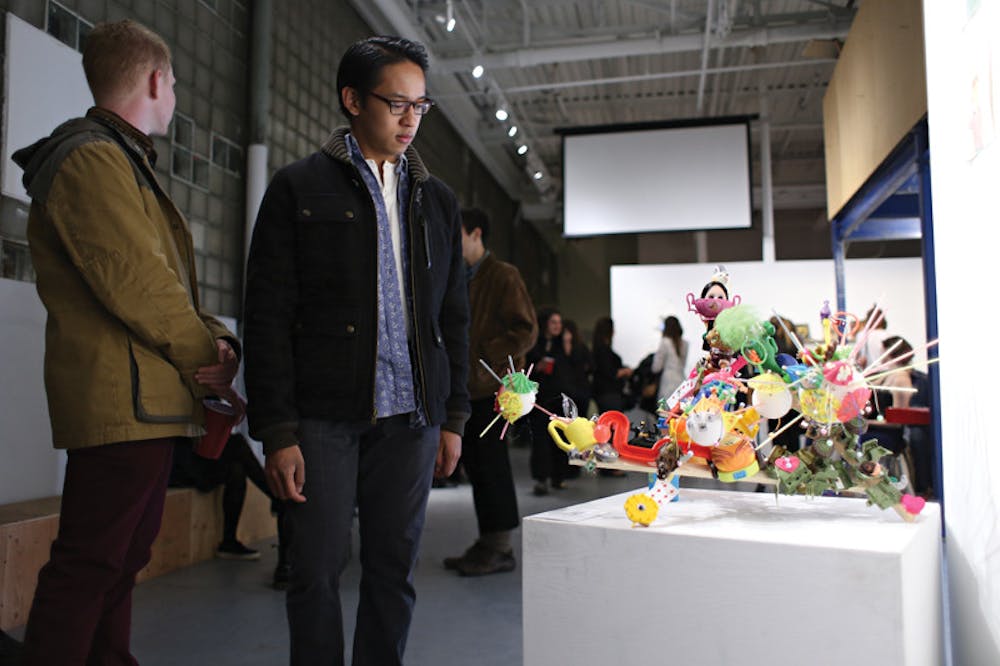Cramming was a requirement — not a sleep-depriving reflection of poor time management — for the student artists and curators in this year’s MESH art show, sponsored by the Student Creative Arts Council. The annual art-creation-and-organization event was contained within a 24-hour period for the first time, said Tiffany Zabludowicz ’14, an event organizer.
“Because it’s so early in the year, artists often don’t have that much work ready yet,” she said of past events. “It always ends up being great, but it’s always slightly stressful leading up to that point. So we figured, why not make that official?”
The allotted time was split evenly between the artists — who created their works between 8 p.m. Friday and 8 a.m. Saturday — and the curators — who took the next 12 hours to arrange the finished products into a coherent whole. At 8 p.m. Saturday, the gallery, located at The Anchor, a warehouse in downtown Providence, opened to the public.
By constraining the artistic and curatorial processes, Zabludowicz hoped to encourage a “mode of discovering the beauty of what can happen when it’s totally organic,” she said, adding that the artists’ “ideas may change, the concepts may change and they may end up collaborating and being influenced by each other.”
This year’s prompt was “material obsession,” according to the event’s official Facebook page. Zabludowicz said SCAC selected this prompt partially because artists at Brown not only commonly deal with themes of “popular culture,” but also because many artists are fixated on “the materials they use and the way they draw on those materials.”
The final exhibit featured a wide range of mediums, styles and artistic statements — from satirical decorations in a model living room to a sculpture composed of toys and games — illustrating the various interpretations of the prompt as well as the creative frenzy of the project itself.
Chae Lin Suh ’14, one of the event’s curators, said she was impressed by the “different stances” with which each artist approached the topic.
“A lot of people used it as an opportunity to critique cultural consumerism and our obsession over drugs, sex and other material-based economy,” she said, adding that others explored the theme through more emotional or psychological lenses.
These interpretations questioned the ways “obsessive practices cause us to develop feelings of passion, fixation, frustration,” as well as how these feelings “make an impact on the individual as a subject and as a body,” she said.
Several artists said they struggled to find inspiration in the face of fatigue.
Jennifer Avery ’16 said her artistic process occurred in “three waves of energy, separated by moments where I very seriously thought I could not do this any longer.”
Theodora Atwater ’16, who sketched a series of illustrations entitled “Things Scott and Louise Want Badly,” echoed this sentiment.
“I hit a wall at about 5 (a.m.) where I couldn’t think of anything that someone would want besides going to sleep,” she said, adding that she replenished her stamina by “watching interviews with quirky musicians, eating Doritos and just walking around.”
Avery — whose exhibit involved faceless dolls arranged amid a flowing, hair-like substance — recalled the pivotal moment when her sewing machine broke at the beginning of the night.
“Twelve hours is not a long time to do something, and suddenly I had to completely reimagine my game plan. All of the planning I had done just went out the window, and I had to think on my feet and figure it out,” she said. “But it was quite thrilling, and I’m pleased with how it all came out.”
Jessica Montes ’16, who attended the art show, said the event was a success.
“I love how this shows materialism through such different scopes that you can visually see as well as feel what it is,” she said, adding that the time limit made the art feel “raw and that much more emotional.”

ADVERTISEMENT




